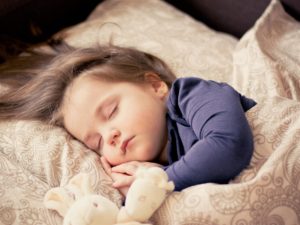Improving Sleep in Children with Autism Spectrum Disorder
Everyone needs sleep and rest to support their health and participate fully in their daily lives. When a child is experiencing sleep difficulties, the sleep quality of the entire family can also be affected. Poor sleep can lead to challenging daytime behaviors and negatively impact daytime function. For children with Autism Spectrum Disorder (ASD) this might look like increased social skills deficits and stereotypic behaviors.
It is not surprising that we hear about sleep issues from our families since over 80% of children with ASD experience sleep disturbance. Sleep disturbance might look like resistance to bedtime, difficulty falling asleep, anxiety related to sleep, sleeping for a short amount of time, waking up at night, daytime sleepiness, excessive movement during sleep, and sleep-disordered breathing such as snoring, groaning, or apnea. Children with ASD sleep less than their typically developing peers.
There are a variety of potential causes for why children with ASD often have problems with sleep. Our bodies produce melatonin which helps us fall asleep. People with autism have higher melatonin levels during the day and lower levels at night. People with ASD can have differences in some of their neurotransmitter systems, making it harder to develop a regular sleep/wake cycle. Additionally, children with ASD often have co-occurring experiences that make sleep disturbance even more likely: anxiety or mood disorders, epilepsy, medication side-effects, GI problems, and sensory dysregulation.
The following are some examples of behavioral interventions and other tips to help improve sleep in children with ASD:
Create a routine that works for your family. Focus on your child’s sensory needs.
- Transitions are hard for children with ASD. A consistent bedtime routine can help ease the transition from daytime to bedtime.
- Set a consistent bedtime and wake time.
- Example routine: put on pajamas, use potty, brush teeth, read story in rocking chair with weighted blanket, turn on sound machine, get in bed, sing song with medium pressure massage, go to sleep.
- Incorporate sensory-based calming activities into the bedtime routine (see tip #4 below).
Use a visual schedule and a bedtime pass.
- Children with ASD are often visual learners. A visual schedule of the bedtime routine can be helpful.
- AUTISM SPEAKS® SLEEP TOOL KIT contains sample visual schedule images and a bedtime pass.
- Take pictures of your children, or use drawn images, to make a visual bedtime schedule.
- Give your child a special “bedtime pass.” They can get up once after they’ve gone to bed and give the pass to you. If they keep the pass the whole night, they get a reward in the morning.
Daytime habits matter!
- Make sure your child gets plenty of sunlight and opportunities to do heavy work activity during the day
Sensory-based calming ideas for bedtime.
- Visual: end screen time 1-2 hrs before bed, black out curtains, red light bulb in the night light, avoid bright colored bedding (red/orange), reduce violent media, Ok to Wake alarm clock (ex. shines green when it’s time to get up, natural light to help wake up over sleepers
- Auditory: sound machine for white noise, rhythmic meditation music
- Tactile: warm bath, comfortable pajamas and sheets
- Vestibular: rocking chair, swing in a back and forth motion and jumping on a trampoline (if calming to your child)
- Taste/Oral: reduce sugar and caffeine in the afternoon and evening, make sure your child is not hungry or thirsty, use a visual timer to increase tolerance to toothbrushing, have a water bottle in bed with a straw to suck
- Proprioceptive: weighted blankets (10% of child’s body weight, only safe when child can remove blanket off themselves), weighted lap blanket, chewy toy
We hope some of these tips can be helpful to you! Leave a comment with any tips that have worked for your child and family.
References:
Cortesi, F., Giannotti, F., Ivanenko, A., & Johnson, K. (2010). Sleep in children with autistic
spectrum disorder. Sleep medicine, 11(7), 659–664. https://doi.org/10.1016/j.sleep.2010.01.010
Ford-Lanza, A. (2017, October 4). What you need to know about autism and sleep. Harkla. https://harkla.co/blogs/special-needs/improve-sleep-autism
H, T. (2017, November 12). Sleep tips for kids with autism. The Pocket OT. https://www.pocketot.com/author/thadsall/
Keogh, S., Bridle, C., Siriwardena, N. A., Nadkarni, A., Laparidou, D., Durrant, S. J., Kargas, N., Law, G. R., & Curtis, F. (2019). Effectiveness of non-pharmacological interventions for insomnia in children with Autism Spectrum Disorder: A systematic review and meta-analysis. PloS one, 14(8), e0221428. https://doi.org/10.1371/journal.pone.0221428
Patterson, K. (2011, February 3). REM sleep disrupted in children with autism. Spectrum. https://www.spectrumnews.org/news/rem-sleep-disrupted-in-children-with-autism/
Prince, K. (2013, May 29). What is stereotypy? The ins and outs of automatically reinforcing behaviors. BCOTB. https://bcotb.com/what-is-stereotypy-the-ins-and-outs-of-automatically-reinforcing-behaviors/
Rogers, C. Trevisan, M., & Traxler, M. (2017). Interventions for sleep problems in pediatrics. (2017). School of Occupational Master’s Capstone Projects, 13. http://soundideas.pugetsound.edu/ot_capstone/13
Springbrook Autism Behavioral Health. (2017, February 7). Heavy work: A beneficial occupational therapy for autism. https://springbrookautismbehavioral.com/portfolio-item/heavy-work-a-beneficial-occupational-therapy-for-autism/
Wooster, D., Gwin, H., Gwin, S., Hargis, L., Papania, J., Register, J., & Rood, K. (2015). Efficacy of sleep education for parents with children with autism spectrum disorder. American Journal of Occupational Therapy, 69(1). https://doi.org/10.5014/ajot.2015.69S1-PO3058








